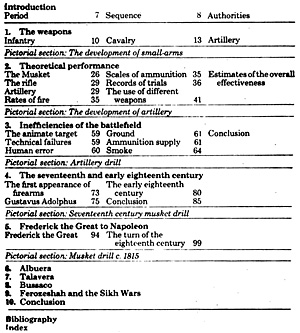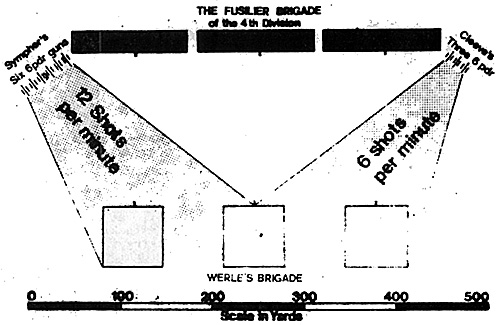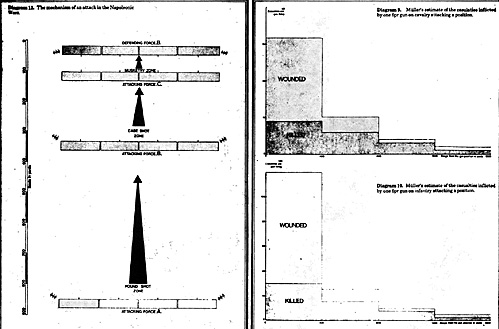
FIREPOWER by Major-General B.P.Hughes. (10" X 7 1/2"; 174 pages; 47 page plates, 15 full page photos; 16 page diagrams and 16 maps. Arms and Armour Press - £ 4.50p).
I find it impossible to speak too highly of this sumptuous book, finding it a landmark at a time when the ready availability of so many excellent books has perhaps tended to jade our palates. More than just finding it fascinatingly readable, I believe it to be an absolute classic in the field of books that accurately and realistically mould the perceptions and rule-formulating of the wargamer specialising in this period i.e. 1630 to 1850.
The discerning reader of military history will long ago have placed the author, MajorGeneral BP Hughes C.B., C.B.E., on his list of writers who know what they are talking about. With such superb volumes as "BRITISH SMOOTHBORE ARTILLERY" and "THE BENGAL HORSE ARTILLERY 1800-1861" under his belt, General Hughes is a writer whose outpourings are eagerly anticipated. "FIREPOWER" maintains his highest standards and the excellence of the text is not only matched by the number and quality of its illustrations but also by the remarkably fine format, from the striking coloured dust-jacket of Waterloo, by Lionel Leventhal and the Arms and Armour Press.
Basically, the book presents a graphic assessment of the effectiveness of smooth-bore firearms on the battlefield and from its text and where can be found the answers to such vital wargaming questions as: How effective was a volley of the muskets of a battalion? How many men were killed or wounded when 500 muskets were fired at 50 yards range? How many casualties could be accounted to a battery of guns operating in support of that battalion? And in what ratios did guns and muskets inflict casualties on the enemy?
 These are problems that lie at the very root of formulating wargames rules, requiring to be
authentically reproduced just as much as are table-top qualities of courage, determination,
fortitude, leadership, skill, dash and endurance. However well we bestow these qualities on our
miniature warriors, the result of their conflicts must be affected by the available weapon-power.
These are problems that lie at the very root of formulating wargames rules, requiring to be
authentically reproduced just as much as are table-top qualities of courage, determination,
fortitude, leadership, skill, dash and endurance. However well we bestow these qualities on our
miniature warriors, the result of their conflicts must be affected by the available weapon-power.
There is no better way to reveal the manner in which this book handles the chosen subject than to reproduce its actual contents list. It shows that the book commences with a brief description of the Army of the period, followed by an appraisal of the theoretical performance of those weapons at their target, both individually and collectively. Then an examination is made of those circumstances which inevitably degraded the theorectical performance of all weapons in battle, leading to a realistic estimate of the performance which could be expected in practice. Finally, the events of a number of battles; are examined in order to apply practical tests to the statements of performance that have been deduced.
The illustration at the top of the last page and on that preceding give a good idea of the quality and value of the book's graphics. In addition I recommend, in particular, the four photographs on pages 24 and 25 which are taken from immediately behind the breech of a smooth-bore muzzle loading gun which, in the first picture is aimed at a single rank of men some 250 yards from the gun; the second photo is at the same distance but the men are in double rank; the third photo is taken at 500 yards and the fourth at 600 yards. It depicts with startling clarity the difficulty of accurate laying even at the moderate fighting range of 600 yards, bearing in mind that the gun had to be completely re-laid after it recoiled on firing and had been run up again on its original gun platform.
The photographs include those of actual weapons of the day, and there are numerous plates of contemporary prints of battles under discussion. The diagrams, such as number 9 on the preceding page, are of inestimable value, giving accurate details of rate of fire and casualty affect that can revolutionise our wargames rules.
For Example
For example, consider the capability of one gun firing on attacking cavalry who cover the first half mile at the trot, the second quarter at a canter and the last quarter at a gallop. At 1,500 to 650 yards from the gun it can fire seven spherical case-shot; at 650 to 350 yards from the gun two round-shot; at 350 to 0 yards two case-shot making a total of eleven rounds loosed off by one gun at the attacking cavalry in the course of their approach. Over the same distance one gun can fire at attacking infantry nineteen spherical case; seven round-shot; eight case-shot, two case-shot, making a total of thirty-six rounds!
The photographs and illustrations are most useful when making models of various guns and pieces of equipment and, in the case of those diagrams comparing British and French infantry dispositions in line and the formations of a battalion, they give valuable information on frontages. Each of the battles described (see Contents List) have sufficient interesting tactical facets to make them worthy of reproduction on the wargames table. The information given in this book will make for a most realistic and authentic simulation.
The last chapter -- the conclusion or summing-up -- is as thought-provoking as everything else in the book. For example
- "It can .... be concluded that there was a belt of a depth of between 30 yards and perhaps as
much as 100 yards within which the musket could develop its maximum effect, and that from a range of 100 yards to 200 yards it was capable only of rapidly diminishing results. The same pattern can be seen in the case of artillery, but with correspondingly longer ranges. All this brings out the fact that, in the days of short ranged weapons with a low rate of fire, the exact placing of the weapons and the timing of their use was of supreme importance. And it was in those respects that inspired commanding leadership could convert what would otherwise have been an inconclusive slogging-match into victory.
The skillful siting and movement of the out-numbered Allied guns and Wellington's quick perception and readjustment of the broken firing line at Talavera; the placing of Hawker's guns at Albuera; Wellington's anticipation of the lines of the French attacks at Bussaco and his movement of the defensive armament to control them; the iron discipline that control - led and the skill that directed, the musket-fire of the 18th century; the careful and deliberate direction of the fire at Gujerat; all of these showed that the outcome of a battle depended to a very considerable extent on the skill with which commanders placed and moved their firearms rather than allowing them to blunder into battle."
If you are one of those wargamers who chafe when a favourite regiment fails to bring down as many of the enemy as you feel they ought, then consider the following extract
- "In the middle of the 18th century, under the most favourable circumstances, in the hands of small numbers of highly skilled and well disciplined infantry and at very short range, it seems that perhaps twenty per cent of the shots ordered to be fired caused casualties. Between fifteen per cent and five per cent of the shots apparently misfired, or at least half of those that left the muzzle failed to reach their mark through a combination of inefficient distribution of fire, inaccurate aiming and, to the greatest extent of all, the eccentricity of the bullet."
What about amending your rules so as to simulate the following aspect of warfare of this period?
- "It was the opening volleys, fired with a clear view under perfect control, that caused many more casualties than were inflicted in the following confused and smoke-impeded exchanges."
A protracted argument that has been filling the correspondence columns of another journal in recent months finds its answer in the following of General Hughes paragraphs:
"It has been asserted by some authorities, whose judgement is questioned with great reluctance, that the standard of musketry of British soldiers was generally higher than the French conscripts. This is much to be expected: the British soldiers had carried out regular live firing practice, but the French conscripts had often never fired their muskets before being plunged into battle. And there are, indeed, some indications of such superiority in the figures that have been presented here, notably in the battle on the ridge at Albuera; but the overall evidence put forward here-is not strong enough to support a claim for universal superiority."
Finally, the book contains, on almost its last page, a precept that would stand any wargamer in good stead - "It was ultimately not weapon power but willpower that won battles; and even though superior weapon power was a powerful lever, it was always a means to an end rather than the end itself."
I am noted for being a highly acquisitive book collector, displaying a marked reluctance to rid myself of even the most uninteresting and unsuitable book. I do not think there is any power on earth that could wrest FIREPOWER by Major-General B.P.Hughes from my bookshelves!

Book Reviews
- Firepower A "Bible" for Wargamers
Blenheim
German Armoured Cars of WWII
Armoured Fighting Vehicles of the World
And Kill MiGs
Back to Table of Contents -- Wargamer's Newsletter # 155
To Wargamer's Newsletter List of Issues
To MagWeb Master Magazine List
© Copyright 1975 by Donald Featherstone.
This article appears in MagWeb (Magazine Web) on the Internet World Wide Web.
Other military history articles and gaming articles are available at http://www.magweb.com